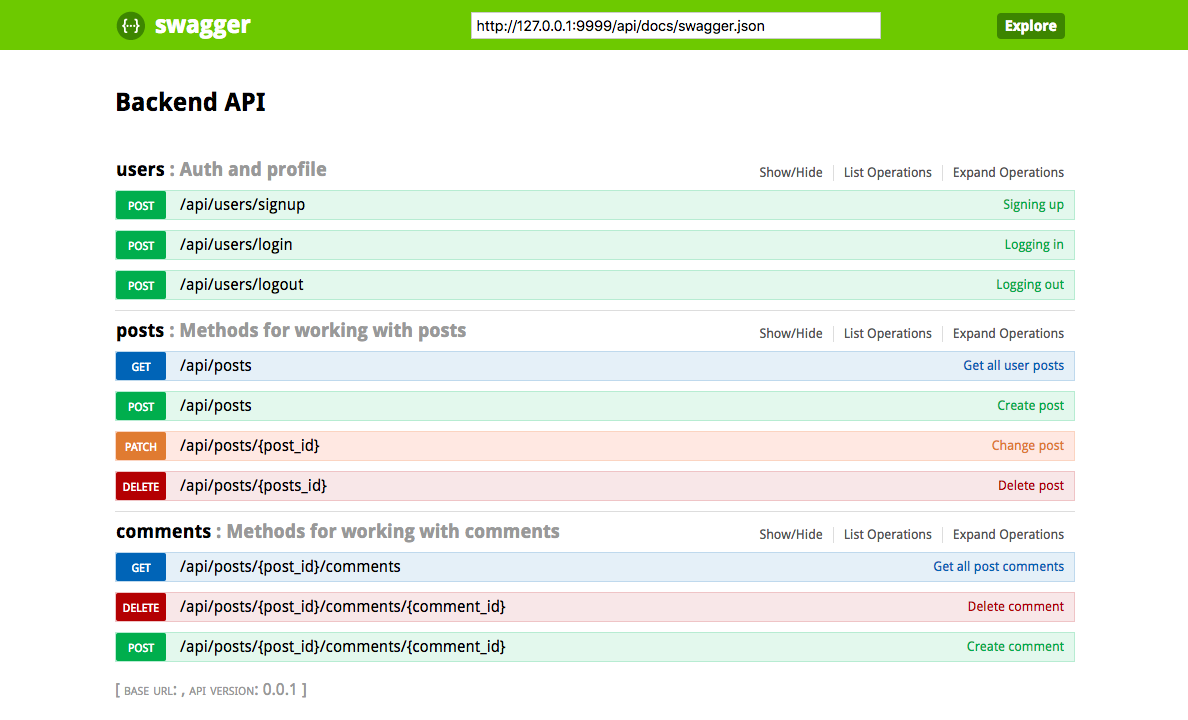Build and document REST APIs with aiohttp and apispec
aiohttp-apispec key features:
docs,use_kwargsandmarshal_withdecorators to add swagger spec support out of the boxvalidation_middlewaremiddleware to enable validating with marshmallow schemas from those decorators
aiohttp-apispec api is fully inspired by flask-apispec library
pip install aiohttp-apispec
from aiohttp_apispec import docs, use_kwargs, marshal_with, setup_aiohttp_apispec
from aiohttp import web
from marshmallow import Schema, fields
class RequestSchema(Schema):
id = fields.Int()
name = fields.Str(description="name")
class ResponseSchema(Schema):
msg = fields.Str()
data = fields.Dict()
@docs(tags=["mytag"],
summary="Test method summary",
description="Test method description")
@use_kwargs(RequestSchema(strict=True))
@marshal_with(ResponseSchema(), 200)
async def index(request):
return web.json_response({"msg": "done", "data": {}})
app = web.Application()
app.router.add_post("/v1/test", index)
# init docs with all parameters, usual for ApiSpec
setup_aiohttp_apispec(app=app, title="My Documentation", version="v1")
# now we can find it on 'http://localhost:8080/api/docs/api-docs'
web.run_app(app)Class based views are also supported:
class TheView(web.View):
@docs(
tags=["mytag"],
summary="View method summary",
description="View method description",
)
@use_kwargs(RequestSchema(strict=True))
@marshal_with(ResponseSchema(), 200)
def delete(self):
return web.json_response(
{"msg": "done", "data": {"name": self.request["data"]["name"]}}
)
app.router.add_view("/v1/view", TheView)from aiohttp_apispec import validation_middleware
...
app.middlewares.append(validation_middleware)Now you can access all validated data in route from request['data'] like so:
@docs(
tags=['mytag'],
summary='Test method summary',
description='Test method description',
)
@use_kwargs(RequestSchema(strict=True))
@marshal_with(ResponseSchema(), 200)
async def index(request):
uid = request['data']['id']
name = request['data']['name']
return web.json_response(
{'msg': 'done', 'data': {'info': f'name - {name}, id - {uid}'}}
)You can change Request's 'data' param to another with request_data_name argument of
setup_aiohttp_apispec function:
setup_aiohttp_apispec(app=app,
request_data_name='validated_data',
title='My Documentation',
version='v1',
url='/api/docs/api-docs')
...
@use_kwargs(RequestSchema(strict=True))
async def index(request):
uid = request['validated_data']['id']
...If you want to catch validation errors you should write your own middleware and catch
web.HTTPClientError, json.JSONDecodeError and so on. Like this:
@web.middleware
async def my_middleware(request, handler):
try:
return await handler(request)
except web.HTTPClientError:
return web.json_response(status=400)
app.middlewares.extend([
my_middleware, # Catch exception by your own, format it and respond to client
validation_middleware,
])aiohttp-apispec adds swagger_dict parameter to aiohttp web application after initialization (with setup_aiohttp_apispec function).
So you can use it easily with aiohttp_swagger library:
from aiohttp_apispec import setup_aiohttp_apispec
from aiohttp_swagger import setup_swagger
def create_app(app):
setup_aiohttp_apispec(app)
async def swagger(app):
setup_swagger(
app=app, swagger_url='/api/doc', swagger_info=app['swagger_dict']
)
app.on_startup.append(swagger)
# now we can access swagger client on '/api/doc' url
...
return app




